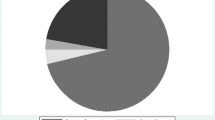Abstract
This study uses micro data from the 1981 March Current Population Survey and incorporates industry merger information from the 1979 FTC Large Mergers and Acquisitions Series to examine the relationship between merger activity and wage levels in U.S. manufacturing. These data sources provide the opportunity to control the wage effect of workers’ differing personal qualities and to allow the investigation of wage levels in five merger categories. The findings suggest that in 1980, employees that work in industries composed of firms formed by horizontal, vertical, and product extension mergers received significantly higher wages than other workers. These results indicate that workers should benefit financially from the recent increase in the number of mergers, other than pure conglomerates.
Similar content being viewed by others
References
Alexander, Kenneth O. “Conglomerate Mergers and Collective Bargaining.”Industrial and Labor Relations Review 24 (April 1972): 354–74.
Belsley, David, Edwin Kuh, and Roy Welsh.Regression Diagnostics: Identifying Influential Data and Sources of Collinearity. New York: John Wiley, 1980.
Brunner, Thomas, Thomas Krattenmaker, Robert Skitol, and Ann Adams-Webster.Mergers in the New Antitrust Era. Washington, DC: The Bureau of National Affairs, Inc., 1985.
Council of Economic Advisors.Economic Report of the President. Washington, DC: U.S. Printing Office, 1987.
Goldberg, Lawrence. “Conglomerate Mergers and Concentration Ratios.”Review of Economics and Statistics 55 (August 1974): 303–309.
Gort, Michael. “An Economic Disturbance Theory of Mergers.”Quarterly Journal of Economics 83 (November 1969): 624–42.
Hendricks, Wallace. “Conglomerate Mergers and Collective Bargaining.”Industrial Relations 15 (February 1976): 75–87.
__, Peter Feuille, and Carol Szerensen. “Regulation, Deregulation, and Collective Bargaining in Airlines.”Industrial and Labor Relations Review 34 (October 1980): 67–81.
Hirsch, Barry and Robert Connolly. “Do Unions Capture Monopoly Profits?”Industrial and Labor Relations Review 41 (October 1987): 118–36.
Horton-Tremblay, Carol. “The Impact of School and College Expenditures on the Wage of Southern and Non-Southern Workers.”Journal of Labor Research 7 (Spring 1986): 201–11.
Karrier, Thomas. “Unions and Monopoly Profits.”Review of Economics and Statistics 67 (February 1985): 34–42.
Kennedy, Peter.A Guide to Econometrics. 2d ed. Cambridge, MA: MIT Press, 1985.
Kokkelenberg, Edward and Donna Sockell. “Union Membership in the United States.”Industrial and Labor Relations Review 38 (July 1985): 387–43.
Leonard, William N. “Mergers, Industrial Concentration, and Antitrust Policy.”Journal of Economic Issues 10 (June 1976): 354–81.
Lewis, Gregg.Union Relative Wage Effects. Chicago: University of Chicago Press, 1985.
Long, James and Albert Link. “The Impact of Market Structure on Wages, Fringe Benefits and Turnover.”Industrial and Labor Relations Review 36 (January 1983): 239–50.
Mueller, Dennis C.The Determinants and Effects on Mergers: An International Comparison. Cambridge, MA: Oelgeschlager, Gunn and Hain, 1980.
Pratten, C. F.Economics of Scale in Manufacturing Industry. Cambridge, England: Cambridge University Press, 1971.
Salinger, Michael A. “Tobin’s q, Unionization, and the Concentration-Profits Relationship.”Rand Journal of Economics 15 (1984): 1134–57.
Scherer, F. M.Industrial Market Structure and Economic Performance. Chicago: Rand McNally, 1980.
Silvey, S. “Multicollinearity and Imprecise Estimations.”Journal of the Royal Statistical Society 31 (1969): 539–52.
U.S. Department of Commerce, Bureau of the Census.Concentration Ratios in Manufacturing: 1982 Census of Manufacturing. Washington, DC: U.S. Government Printing Office, 1982.
U.S. Department of Labor, Bureau of Labor Statistics.Employment and Earnings, July 1981. Washington, DC: U.S. Government Printing Office, 1981.
Wetlaufer, Gerald. “Notes on the New Merger Guidelines.”Mergers and Acquisitions 17 (Summer 1982): 18–20.
Author information
Authors and Affiliations
Additional information
The author thanks William Jones, Peter Loeb, and Leo Troy for their valuable suggestions. The author is also grateful to the Rutgers University Research Council for support of this project.
Rights and permissions
About this article
Cite this article
Peoples, J. Merger activity and wage levels in U.S. manufacturing. Journal of Labor Research 10, 183–196 (1989). https://doi.org/10.1007/BF02685263
Issue Date:
DOI: https://doi.org/10.1007/BF02685263




